Business Environment Analysis Report
VerifiedAdded on 2020/10/22
|18
|5646
|491
Report
AI Summary
This report provides an in-depth analysis of the business environment affecting Nestle, covering various organizational types, their functions, and the impact of macroeconomic factors. It includes a SWOT analysis to identify strengths and weaknesses, as well as a PESTLE analysis to evaluate external influences. The report emphasizes the importance of understanding the business environment for strategic planning and operational success.
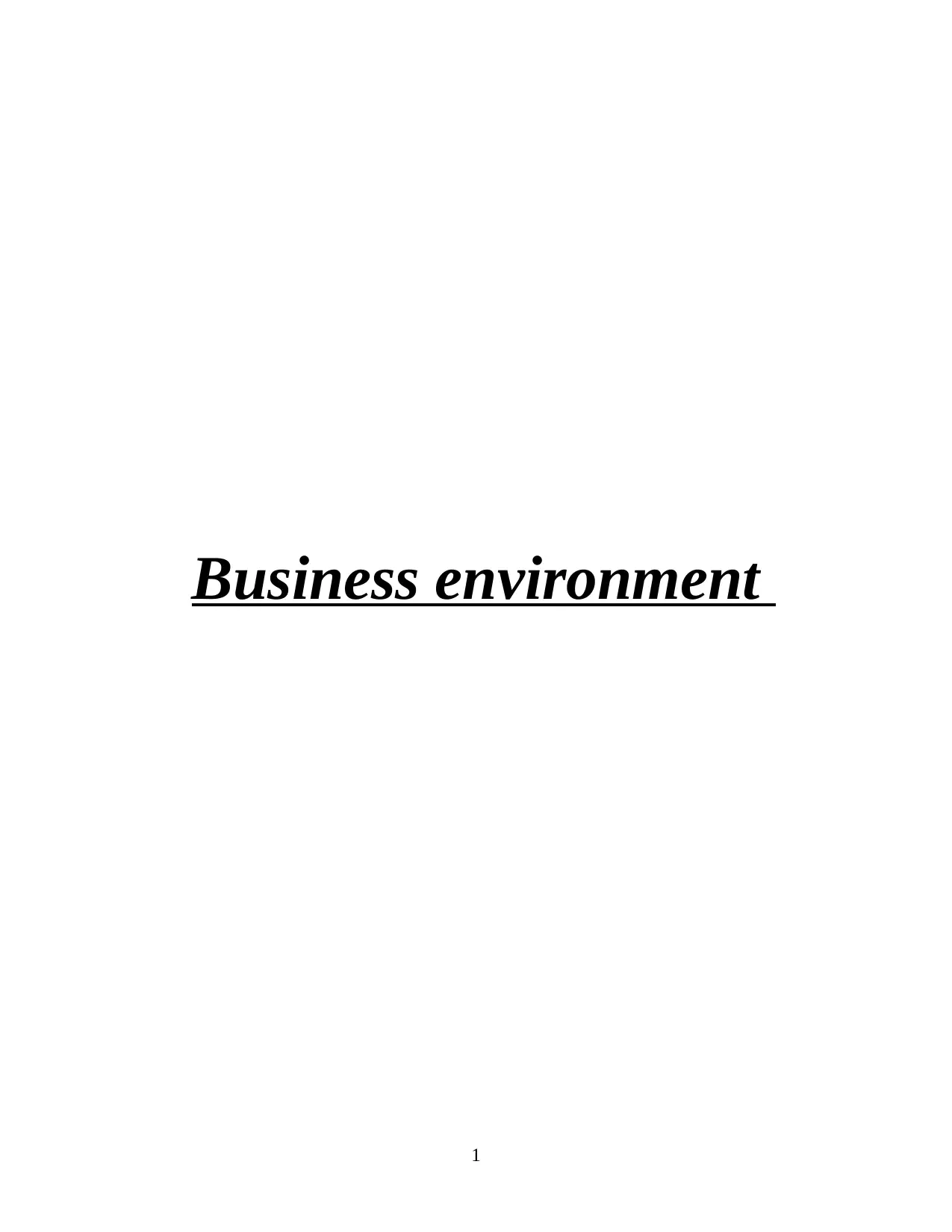
Business environment
1
1
Paraphrase This Document
Need a fresh take? Get an instant paraphrase of this document with our AI Paraphraser
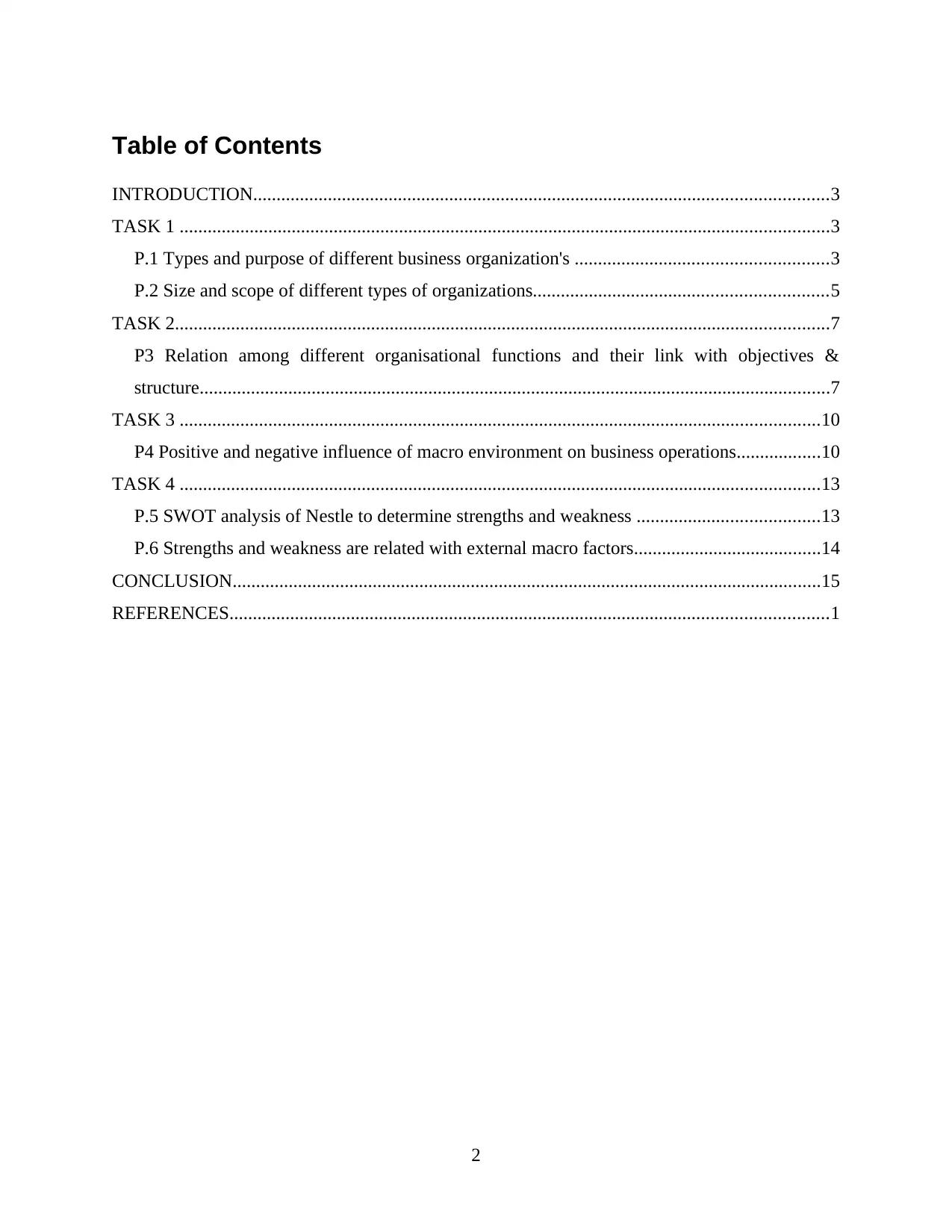
Table of Contents
INTRODUCTION...........................................................................................................................3
TASK 1 ...........................................................................................................................................3
P.1 Types and purpose of different business organization's ......................................................3
P.2 Size and scope of different types of organizations...............................................................5
TASK 2............................................................................................................................................7
P3 Relation among different organisational functions and their link with objectives &
structure.......................................................................................................................................7
TASK 3 .........................................................................................................................................10
P4 Positive and negative influence of macro environment on business operations..................10
TASK 4 .........................................................................................................................................13
P.5 SWOT analysis of Nestle to determine strengths and weakness .......................................13
P.6 Strengths and weakness are related with external macro factors........................................14
CONCLUSION..............................................................................................................................15
REFERENCES................................................................................................................................1
2
INTRODUCTION...........................................................................................................................3
TASK 1 ...........................................................................................................................................3
P.1 Types and purpose of different business organization's ......................................................3
P.2 Size and scope of different types of organizations...............................................................5
TASK 2............................................................................................................................................7
P3 Relation among different organisational functions and their link with objectives &
structure.......................................................................................................................................7
TASK 3 .........................................................................................................................................10
P4 Positive and negative influence of macro environment on business operations..................10
TASK 4 .........................................................................................................................................13
P.5 SWOT analysis of Nestle to determine strengths and weakness .......................................13
P.6 Strengths and weakness are related with external macro factors........................................14
CONCLUSION..............................................................................................................................15
REFERENCES................................................................................................................................1
2
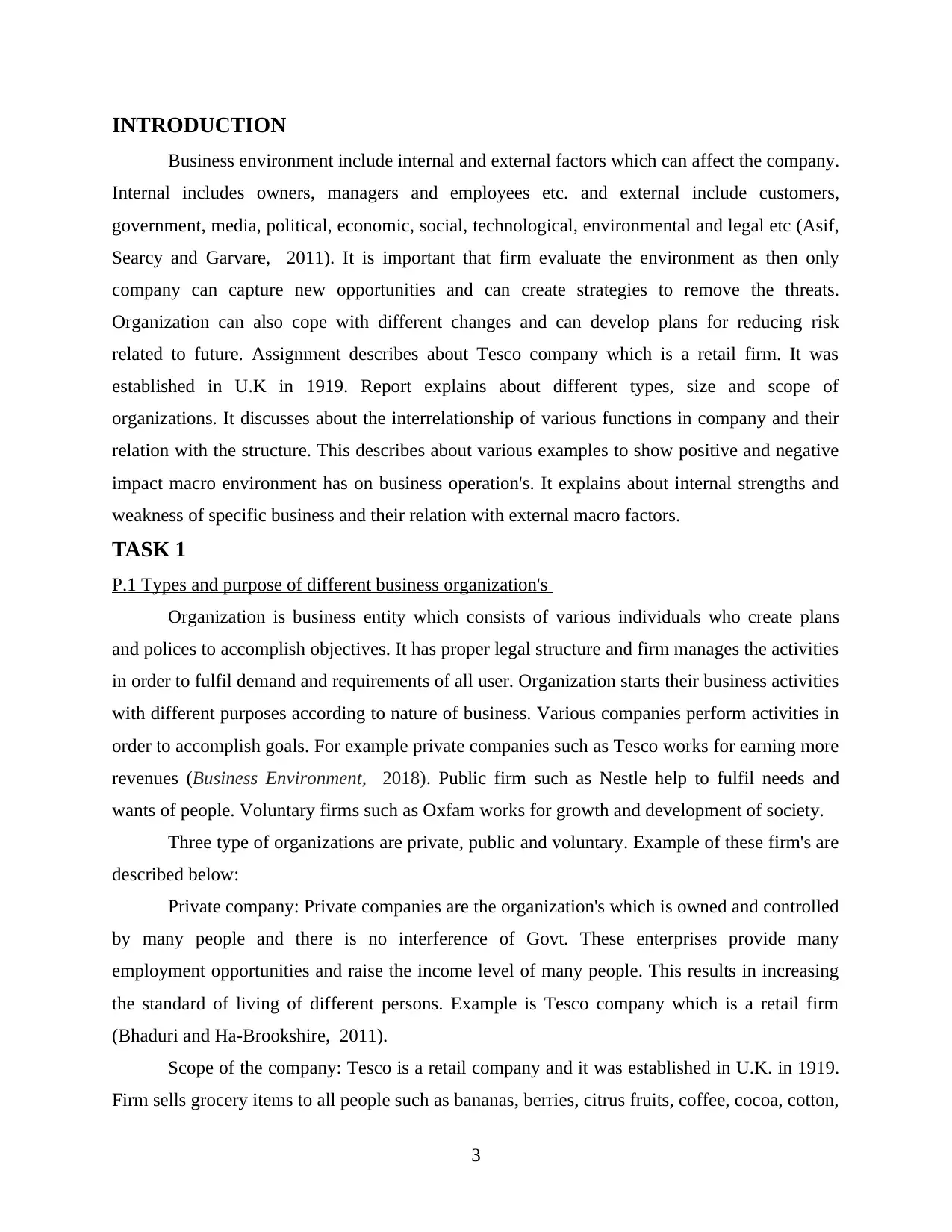
INTRODUCTION
Business environment include internal and external factors which can affect the company.
Internal includes owners, managers and employees etc. and external include customers,
government, media, political, economic, social, technological, environmental and legal etc (Asif,
Searcy and Garvare, 2011). It is important that firm evaluate the environment as then only
company can capture new opportunities and can create strategies to remove the threats.
Organization can also cope with different changes and can develop plans for reducing risk
related to future. Assignment describes about Tesco company which is a retail firm. It was
established in U.K in 1919. Report explains about different types, size and scope of
organizations. It discusses about the interrelationship of various functions in company and their
relation with the structure. This describes about various examples to show positive and negative
impact macro environment has on business operation's. It explains about internal strengths and
weakness of specific business and their relation with external macro factors.
TASK 1
P.1 Types and purpose of different business organization's
Organization is business entity which consists of various individuals who create plans
and polices to accomplish objectives. It has proper legal structure and firm manages the activities
in order to fulfil demand and requirements of all user. Organization starts their business activities
with different purposes according to nature of business. Various companies perform activities in
order to accomplish goals. For example private companies such as Tesco works for earning more
revenues (Business Environment, 2018). Public firm such as Nestle help to fulfil needs and
wants of people. Voluntary firms such as Oxfam works for growth and development of society.
Three type of organizations are private, public and voluntary. Example of these firm's are
described below:
Private company: Private companies are the organization's which is owned and controlled
by many people and there is no interference of Govt. These enterprises provide many
employment opportunities and raise the income level of many people. This results in increasing
the standard of living of different persons. Example is Tesco company which is a retail firm
(Bhaduri and Ha-Brookshire, 2011).
Scope of the company: Tesco is a retail company and it was established in U.K. in 1919.
Firm sells grocery items to all people such as bananas, berries, citrus fruits, coffee, cocoa, cotton,
3
Business environment include internal and external factors which can affect the company.
Internal includes owners, managers and employees etc. and external include customers,
government, media, political, economic, social, technological, environmental and legal etc (Asif,
Searcy and Garvare, 2011). It is important that firm evaluate the environment as then only
company can capture new opportunities and can create strategies to remove the threats.
Organization can also cope with different changes and can develop plans for reducing risk
related to future. Assignment describes about Tesco company which is a retail firm. It was
established in U.K in 1919. Report explains about different types, size and scope of
organizations. It discusses about the interrelationship of various functions in company and their
relation with the structure. This describes about various examples to show positive and negative
impact macro environment has on business operation's. It explains about internal strengths and
weakness of specific business and their relation with external macro factors.
TASK 1
P.1 Types and purpose of different business organization's
Organization is business entity which consists of various individuals who create plans
and polices to accomplish objectives. It has proper legal structure and firm manages the activities
in order to fulfil demand and requirements of all user. Organization starts their business activities
with different purposes according to nature of business. Various companies perform activities in
order to accomplish goals. For example private companies such as Tesco works for earning more
revenues (Business Environment, 2018). Public firm such as Nestle help to fulfil needs and
wants of people. Voluntary firms such as Oxfam works for growth and development of society.
Three type of organizations are private, public and voluntary. Example of these firm's are
described below:
Private company: Private companies are the organization's which is owned and controlled
by many people and there is no interference of Govt. These enterprises provide many
employment opportunities and raise the income level of many people. This results in increasing
the standard of living of different persons. Example is Tesco company which is a retail firm
(Bhaduri and Ha-Brookshire, 2011).
Scope of the company: Tesco is a retail company and it was established in U.K. in 1919.
Firm sells grocery items to all people such as bananas, berries, citrus fruits, coffee, cocoa, cotton,
3
⊘ This is a preview!⊘
Do you want full access?
Subscribe today to unlock all pages.

Trusted by 1+ million students worldwide
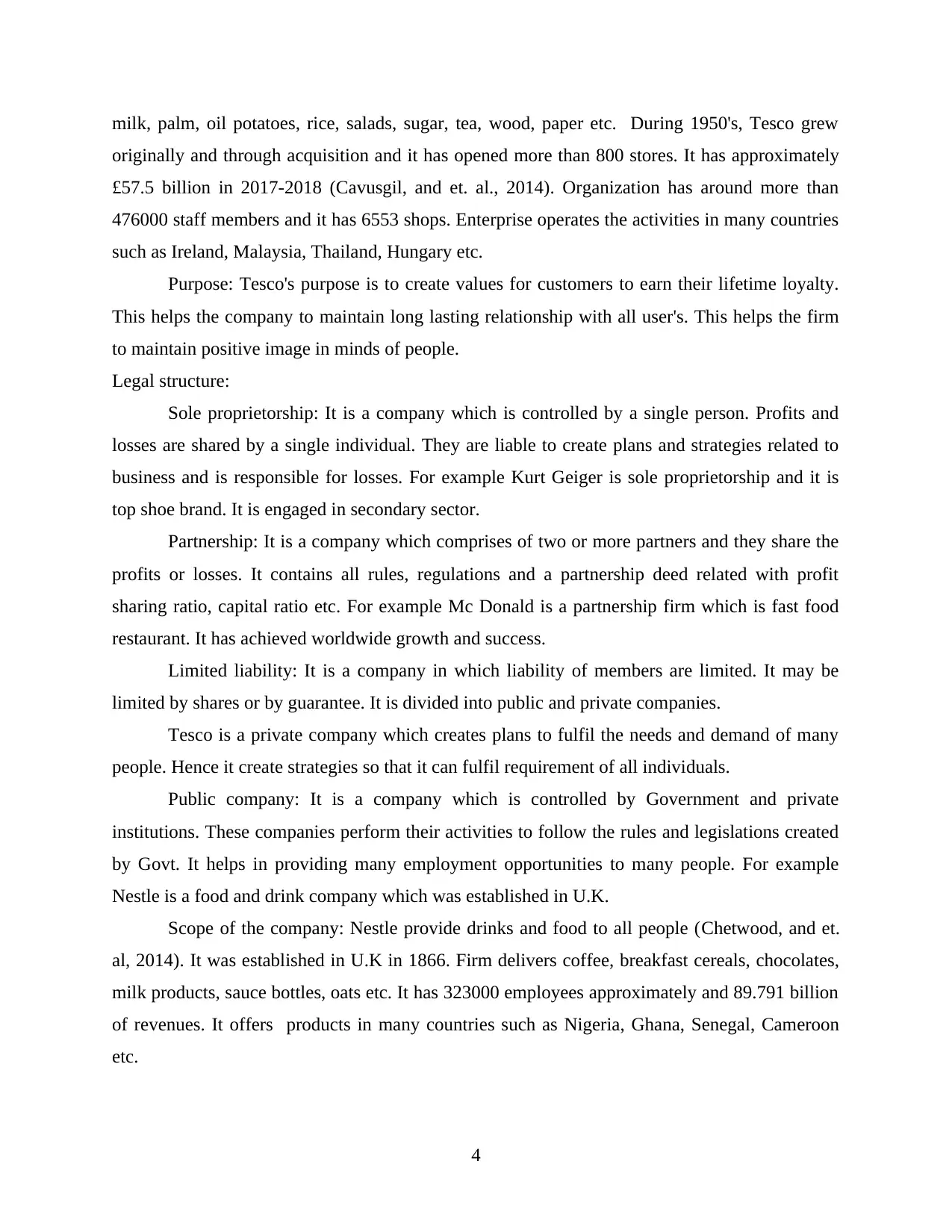
milk, palm, oil potatoes, rice, salads, sugar, tea, wood, paper etc. During 1950's, Tesco grew
originally and through acquisition and it has opened more than 800 stores. It has approximately
£57.5 billion in 2017-2018 (Cavusgil, and et. al., 2014). Organization has around more than
476000 staff members and it has 6553 shops. Enterprise operates the activities in many countries
such as Ireland, Malaysia, Thailand, Hungary etc.
Purpose: Tesco's purpose is to create values for customers to earn their lifetime loyalty.
This helps the company to maintain long lasting relationship with all user's. This helps the firm
to maintain positive image in minds of people.
Legal structure:
Sole proprietorship: It is a company which is controlled by a single person. Profits and
losses are shared by a single individual. They are liable to create plans and strategies related to
business and is responsible for losses. For example Kurt Geiger is sole proprietorship and it is
top shoe brand. It is engaged in secondary sector.
Partnership: It is a company which comprises of two or more partners and they share the
profits or losses. It contains all rules, regulations and a partnership deed related with profit
sharing ratio, capital ratio etc. For example Mc Donald is a partnership firm which is fast food
restaurant. It has achieved worldwide growth and success.
Limited liability: It is a company in which liability of members are limited. It may be
limited by shares or by guarantee. It is divided into public and private companies.
Tesco is a private company which creates plans to fulfil the needs and demand of many
people. Hence it create strategies so that it can fulfil requirement of all individuals.
Public company: It is a company which is controlled by Government and private
institutions. These companies perform their activities to follow the rules and legislations created
by Govt. It helps in providing many employment opportunities to many people. For example
Nestle is a food and drink company which was established in U.K.
Scope of the company: Nestle provide drinks and food to all people (Chetwood, and et.
al, 2014). It was established in U.K in 1866. Firm delivers coffee, breakfast cereals, chocolates,
milk products, sauce bottles, oats etc. It has 323000 employees approximately and 89.791 billion
of revenues. It offers products in many countries such as Nigeria, Ghana, Senegal, Cameroon
etc.
4
originally and through acquisition and it has opened more than 800 stores. It has approximately
£57.5 billion in 2017-2018 (Cavusgil, and et. al., 2014). Organization has around more than
476000 staff members and it has 6553 shops. Enterprise operates the activities in many countries
such as Ireland, Malaysia, Thailand, Hungary etc.
Purpose: Tesco's purpose is to create values for customers to earn their lifetime loyalty.
This helps the company to maintain long lasting relationship with all user's. This helps the firm
to maintain positive image in minds of people.
Legal structure:
Sole proprietorship: It is a company which is controlled by a single person. Profits and
losses are shared by a single individual. They are liable to create plans and strategies related to
business and is responsible for losses. For example Kurt Geiger is sole proprietorship and it is
top shoe brand. It is engaged in secondary sector.
Partnership: It is a company which comprises of two or more partners and they share the
profits or losses. It contains all rules, regulations and a partnership deed related with profit
sharing ratio, capital ratio etc. For example Mc Donald is a partnership firm which is fast food
restaurant. It has achieved worldwide growth and success.
Limited liability: It is a company in which liability of members are limited. It may be
limited by shares or by guarantee. It is divided into public and private companies.
Tesco is a private company which creates plans to fulfil the needs and demand of many
people. Hence it create strategies so that it can fulfil requirement of all individuals.
Public company: It is a company which is controlled by Government and private
institutions. These companies perform their activities to follow the rules and legislations created
by Govt. It helps in providing many employment opportunities to many people. For example
Nestle is a food and drink company which was established in U.K.
Scope of the company: Nestle provide drinks and food to all people (Chetwood, and et.
al, 2014). It was established in U.K in 1866. Firm delivers coffee, breakfast cereals, chocolates,
milk products, sauce bottles, oats etc. It has 323000 employees approximately and 89.791 billion
of revenues. It offers products in many countries such as Nigeria, Ghana, Senegal, Cameroon
etc.
4
Paraphrase This Document
Need a fresh take? Get an instant paraphrase of this document with our AI Paraphraser

Purpose: It's main purpose is to enhance the quality of life and contributing to healthier
future. This helps the company to capture many people and firm can maintain positive image in
minds all people (Crane and Matten, 2016).
Legal structure:
Central Govt.: It covers many departmental functions in accurate manner and cover
things in proper way. It is the supreme Govt. and it has distinct powers at various level
authorised or delegated at various levels.
State Govt.: They are the Government which rules states and head of council of ministers
is chief minister. It deals with internal security and other state issues.
Local Govt.: Local Govt. is public administration of towns, villages, cities and districts.
They derive their authorities from the state in which they are located.
Voluntary company: These companies are created with support from business man and big
industrialist in form of getting funds as charity. It is formed with objective to eliminate social
issues from the country. For example Oxfam is a voluntary firm and was established in U.K.
Overview of company: Oxfam is a voluntary firm which was established in U.K in 1942. It
wants to eliminate poverty from country. The operation's and activities are run by assistance of
Volunteers. It also administer food to many people and provides support to individuals so
that they can survive in country. Organization has approximately 31000 volunteers and 2500
staff. It has £414.7 million. It provide services in many nations.
Purpose: Main purpose is to create lasting solutions to injustice of poverty. It has to
create future that is secure and free from the poverty.
Legal structure:
Community benefit society: It is incorporated by separate legal entity and is controlled by
financial conduct authority. Business was run in interests of the community.
Community interest company: It was incorporated by separate government and regulated
by CIC regulator. It was innovated in 2007 as new corporate structure for non chartable company
that want to use their assets and profits for public good (Gharajedaghi, 2011).
P.2 Size and scope of different types of organizations
Size, scope and objectives of three companies: This is an important part which help in
expansion of the company's activities at different level.
Tesco
5
future. This helps the company to capture many people and firm can maintain positive image in
minds all people (Crane and Matten, 2016).
Legal structure:
Central Govt.: It covers many departmental functions in accurate manner and cover
things in proper way. It is the supreme Govt. and it has distinct powers at various level
authorised or delegated at various levels.
State Govt.: They are the Government which rules states and head of council of ministers
is chief minister. It deals with internal security and other state issues.
Local Govt.: Local Govt. is public administration of towns, villages, cities and districts.
They derive their authorities from the state in which they are located.
Voluntary company: These companies are created with support from business man and big
industrialist in form of getting funds as charity. It is formed with objective to eliminate social
issues from the country. For example Oxfam is a voluntary firm and was established in U.K.
Overview of company: Oxfam is a voluntary firm which was established in U.K in 1942. It
wants to eliminate poverty from country. The operation's and activities are run by assistance of
Volunteers. It also administer food to many people and provides support to individuals so
that they can survive in country. Organization has approximately 31000 volunteers and 2500
staff. It has £414.7 million. It provide services in many nations.
Purpose: Main purpose is to create lasting solutions to injustice of poverty. It has to
create future that is secure and free from the poverty.
Legal structure:
Community benefit society: It is incorporated by separate legal entity and is controlled by
financial conduct authority. Business was run in interests of the community.
Community interest company: It was incorporated by separate government and regulated
by CIC regulator. It was innovated in 2007 as new corporate structure for non chartable company
that want to use their assets and profits for public good (Gharajedaghi, 2011).
P.2 Size and scope of different types of organizations
Size, scope and objectives of three companies: This is an important part which help in
expansion of the company's activities at different level.
Tesco
5

Size: It is a retail company which was established in U.K. In 1919. It is a retail shop
which has different operations in many countries such as Ireland, Malaysia, Thailand, Hungary
etc. It operates in many countries, it has 6553 shops and firm has more than 476000 staff
members (Gilboy, 2016). Organization has approximately £57.5 billion in 2017-2018. It creates
strategies and plans to continuously expand and diversify their activities and operations. In this
manner, company can earn huge profits and can enhance te market share.
Scope: It operates in many countries and sells different products. Firm sells milk, palm,
oil potatoes, rice, salads, sugar, tea, wood, paper, bananas, berries, citrus fruits, coffee, cocoa,
cotton, etc. to many people. This helps the company to maintain positive image in minds of all
people.
Objective: It has objective to deliver services so that they can create loyalty for the brand.
Vision: It's vision is to become the highly valued business so that it can capture many
customers. This helps the company to create brand loyalty.
Mission: It's main mission is to create a long lasting value for the customers. This helps
the organization to earn more revenues and to increase the market share.
Nestle:
Size: Nestle is a company which was established in U.K in 1866. It delivers food and
drink to many people. This helps the company to maintain positive image in minds of all user's.
Organization has 89.791 billion of revenues and 323000 employees approximately. It offers
products in many countries such as Cameroon, Nigeria, Ghana, Senegal, etc. This helps the
company to expand their activities in many countries and to diversify their operations in less
time.
Scope: Nestle provides different product to many people living in different countries.
Firm delivers milk products, sauce bottles, oats, coffee, breakfast cereals, chocolates, etc.
Objective: It's main objective is to develop safe and wholesome foods by using unique
packaged materials and it helps in increasing satisfaction of all people (Kian Chong, Shafaghi
and Leing Tan, 2011).
Vision: It's main vision is to become leading, competitive, health and Wellness company.
Mission: It's main mission is to provide healthy and nutritious food to all people and
increasing satisfaction level of people.
Oxfam:
6
which has different operations in many countries such as Ireland, Malaysia, Thailand, Hungary
etc. It operates in many countries, it has 6553 shops and firm has more than 476000 staff
members (Gilboy, 2016). Organization has approximately £57.5 billion in 2017-2018. It creates
strategies and plans to continuously expand and diversify their activities and operations. In this
manner, company can earn huge profits and can enhance te market share.
Scope: It operates in many countries and sells different products. Firm sells milk, palm,
oil potatoes, rice, salads, sugar, tea, wood, paper, bananas, berries, citrus fruits, coffee, cocoa,
cotton, etc. to many people. This helps the company to maintain positive image in minds of all
people.
Objective: It has objective to deliver services so that they can create loyalty for the brand.
Vision: It's vision is to become the highly valued business so that it can capture many
customers. This helps the company to create brand loyalty.
Mission: It's main mission is to create a long lasting value for the customers. This helps
the organization to earn more revenues and to increase the market share.
Nestle:
Size: Nestle is a company which was established in U.K in 1866. It delivers food and
drink to many people. This helps the company to maintain positive image in minds of all user's.
Organization has 89.791 billion of revenues and 323000 employees approximately. It offers
products in many countries such as Cameroon, Nigeria, Ghana, Senegal, etc. This helps the
company to expand their activities in many countries and to diversify their operations in less
time.
Scope: Nestle provides different product to many people living in different countries.
Firm delivers milk products, sauce bottles, oats, coffee, breakfast cereals, chocolates, etc.
Objective: It's main objective is to develop safe and wholesome foods by using unique
packaged materials and it helps in increasing satisfaction of all people (Kian Chong, Shafaghi
and Leing Tan, 2011).
Vision: It's main vision is to become leading, competitive, health and Wellness company.
Mission: It's main mission is to provide healthy and nutritious food to all people and
increasing satisfaction level of people.
Oxfam:
6
⊘ This is a preview!⊘
Do you want full access?
Subscribe today to unlock all pages.

Trusted by 1+ million students worldwide

Size: Oxfam is a voluntary firm which was established in U.K in 1942. It create plans
and policies to reduce the poverty from country. Organization has 2500 staff and approximately
31000 volunteers (Li, and et. al., 2011). It has £414.7 million of revenues in 2017-2018. It
provide services in many nations.
Scope: Oxfam tries to reduce poverty from country by creating plans and polices. Firm
also creates a Right based approach in which people are given rights related to civil, political and
social. This helps the firm to maintain positive image in minds of all people.
Objective: It's main objective is to provide is to help people so that they can exercise their
civil and political rights.
Vision: Company wants to teat all persons equally and enjoy full rights and can take their
decisions.
Mission: Main mission is to give lasting solutions to injustice of poverty. Firm tries to
end the poverty from the country.
Shareholder mapping: It is the degree of interest of each stakeholder group in influencing
proposed plans of organization. It has four subcategories:
Category 1: Low power/ Low interest: In this category stakeholders have little influence
on proposed strategy. These stakeholders do not want to block or support proposed expansion.
Category 2: Low power/ high interest stakeholder: Stakeholders have little power to
influence the strategy. Stakeholders have high degree of interest in company's plans.
Category 3: High power/ Low interest: Stakeholders have low interest in company's plans
and they do not have power to influence them. These stakeholders need to be kept satisfied.
Category 4: High power/Low interest stakeholders: These stakeholders can affect the
proposed strategy either as facilitators or blocker's. They can be encouraged to act as supporters.
TASK 2
P3 Relation among different organisational functions and their link with objectives & structure
A business and organizational function is a main process and set of activities executed
within an areas or department of a firm (López-Gamero, Molina-Azorín and Claver-Cortés,
2011). Common functions of every company includes marketing, operations, information
technology, human resources, finance and customer services. Along with them, organizational
structure is refers as a network of effective relationship in which the activity classified into units.
7
and policies to reduce the poverty from country. Organization has 2500 staff and approximately
31000 volunteers (Li, and et. al., 2011). It has £414.7 million of revenues in 2017-2018. It
provide services in many nations.
Scope: Oxfam tries to reduce poverty from country by creating plans and polices. Firm
also creates a Right based approach in which people are given rights related to civil, political and
social. This helps the firm to maintain positive image in minds of all people.
Objective: It's main objective is to provide is to help people so that they can exercise their
civil and political rights.
Vision: Company wants to teat all persons equally and enjoy full rights and can take their
decisions.
Mission: Main mission is to give lasting solutions to injustice of poverty. Firm tries to
end the poverty from the country.
Shareholder mapping: It is the degree of interest of each stakeholder group in influencing
proposed plans of organization. It has four subcategories:
Category 1: Low power/ Low interest: In this category stakeholders have little influence
on proposed strategy. These stakeholders do not want to block or support proposed expansion.
Category 2: Low power/ high interest stakeholder: Stakeholders have little power to
influence the strategy. Stakeholders have high degree of interest in company's plans.
Category 3: High power/ Low interest: Stakeholders have low interest in company's plans
and they do not have power to influence them. These stakeholders need to be kept satisfied.
Category 4: High power/Low interest stakeholders: These stakeholders can affect the
proposed strategy either as facilitators or blocker's. They can be encouraged to act as supporters.
TASK 2
P3 Relation among different organisational functions and their link with objectives & structure
A business and organizational function is a main process and set of activities executed
within an areas or department of a firm (López-Gamero, Molina-Azorín and Claver-Cortés,
2011). Common functions of every company includes marketing, operations, information
technology, human resources, finance and customer services. Along with them, organizational
structure is refers as a network of effective relationship in which the activity classified into units.
7
Paraphrase This Document
Need a fresh take? Get an instant paraphrase of this document with our AI Paraphraser

This division of work is assisting in bringing specialization in different activities of firm. Nestle
company has different functions which are determined as under:
Illustration 1: Organisation function of Nestle
(Source: Organisation functions of Nestle)
Finance: This is a main department in the Nestle and play vital role in arranging
appropriate amount of capital (Meiners Ringleb, and Edwards, 2014). This function support in
creating future budgets and also allotment capital to other department for different activities.
Finance manager must organise with other division so they have accurate data regarding the
capital which is followed by another department of a company. It assist Nestle in managing
capital investment, cash flow and current assets. Finance department of Nestle help marketing
division of company by preparing proper budget for its various promotional or marketing
strategies. Also it provide information to the marketing manager about market and project to
execute. This division support the organisation to accomplish their desired goals and targets
within predetermined time duration.
Human resource: This department is more important in an enterprise as it main function
is to hire knowledgeable and talented workforce. Another function of this division is to provide
training and development class to the employees who have lack of knowledge regarding business
8
company has different functions which are determined as under:
Illustration 1: Organisation function of Nestle
(Source: Organisation functions of Nestle)
Finance: This is a main department in the Nestle and play vital role in arranging
appropriate amount of capital (Meiners Ringleb, and Edwards, 2014). This function support in
creating future budgets and also allotment capital to other department for different activities.
Finance manager must organise with other division so they have accurate data regarding the
capital which is followed by another department of a company. It assist Nestle in managing
capital investment, cash flow and current assets. Finance department of Nestle help marketing
division of company by preparing proper budget for its various promotional or marketing
strategies. Also it provide information to the marketing manager about market and project to
execute. This division support the organisation to accomplish their desired goals and targets
within predetermined time duration.
Human resource: This department is more important in an enterprise as it main function
is to hire knowledgeable and talented workforce. Another function of this division is to provide
training and development class to the employees who have lack of knowledge regarding business
8
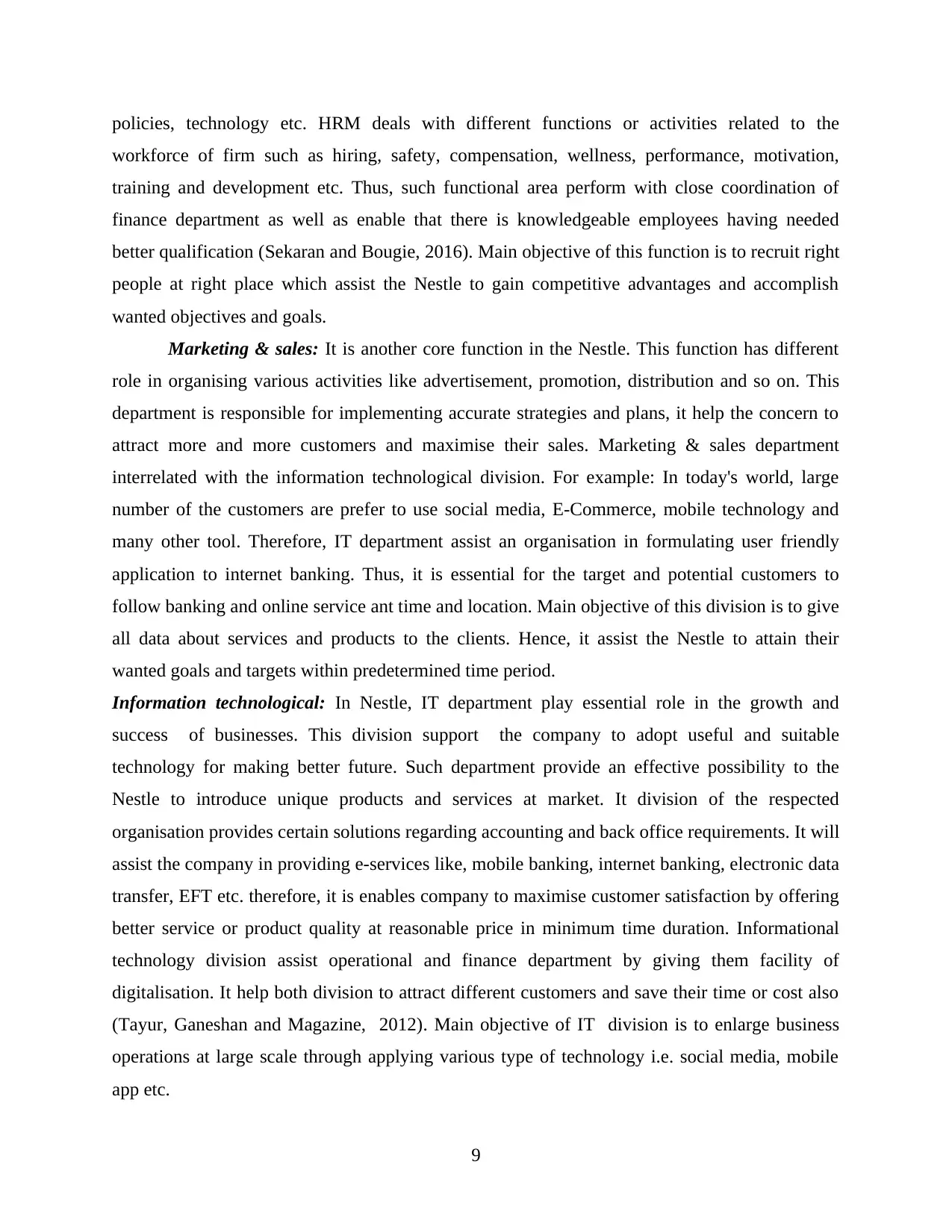
policies, technology etc. HRM deals with different functions or activities related to the
workforce of firm such as hiring, safety, compensation, wellness, performance, motivation,
training and development etc. Thus, such functional area perform with close coordination of
finance department as well as enable that there is knowledgeable employees having needed
better qualification (Sekaran and Bougie, 2016). Main objective of this function is to recruit right
people at right place which assist the Nestle to gain competitive advantages and accomplish
wanted objectives and goals.
Marketing & sales: It is another core function in the Nestle. This function has different
role in organising various activities like advertisement, promotion, distribution and so on. This
department is responsible for implementing accurate strategies and plans, it help the concern to
attract more and more customers and maximise their sales. Marketing & sales department
interrelated with the information technological division. For example: In today's world, large
number of the customers are prefer to use social media, E-Commerce, mobile technology and
many other tool. Therefore, IT department assist an organisation in formulating user friendly
application to internet banking. Thus, it is essential for the target and potential customers to
follow banking and online service ant time and location. Main objective of this division is to give
all data about services and products to the clients. Hence, it assist the Nestle to attain their
wanted goals and targets within predetermined time period.
Information technological: In Nestle, IT department play essential role in the growth and
success of businesses. This division support the company to adopt useful and suitable
technology for making better future. Such department provide an effective possibility to the
Nestle to introduce unique products and services at market. It division of the respected
organisation provides certain solutions regarding accounting and back office requirements. It will
assist the company in providing e-services like, mobile banking, internet banking, electronic data
transfer, EFT etc. therefore, it is enables company to maximise customer satisfaction by offering
better service or product quality at reasonable price in minimum time duration. Informational
technology division assist operational and finance department by giving them facility of
digitalisation. It help both division to attract different customers and save their time or cost also
(Tayur, Ganeshan and Magazine, 2012). Main objective of IT division is to enlarge business
operations at large scale through applying various type of technology i.e. social media, mobile
app etc.
9
workforce of firm such as hiring, safety, compensation, wellness, performance, motivation,
training and development etc. Thus, such functional area perform with close coordination of
finance department as well as enable that there is knowledgeable employees having needed
better qualification (Sekaran and Bougie, 2016). Main objective of this function is to recruit right
people at right place which assist the Nestle to gain competitive advantages and accomplish
wanted objectives and goals.
Marketing & sales: It is another core function in the Nestle. This function has different
role in organising various activities like advertisement, promotion, distribution and so on. This
department is responsible for implementing accurate strategies and plans, it help the concern to
attract more and more customers and maximise their sales. Marketing & sales department
interrelated with the information technological division. For example: In today's world, large
number of the customers are prefer to use social media, E-Commerce, mobile technology and
many other tool. Therefore, IT department assist an organisation in formulating user friendly
application to internet banking. Thus, it is essential for the target and potential customers to
follow banking and online service ant time and location. Main objective of this division is to give
all data about services and products to the clients. Hence, it assist the Nestle to attain their
wanted goals and targets within predetermined time period.
Information technological: In Nestle, IT department play essential role in the growth and
success of businesses. This division support the company to adopt useful and suitable
technology for making better future. Such department provide an effective possibility to the
Nestle to introduce unique products and services at market. It division of the respected
organisation provides certain solutions regarding accounting and back office requirements. It will
assist the company in providing e-services like, mobile banking, internet banking, electronic data
transfer, EFT etc. therefore, it is enables company to maximise customer satisfaction by offering
better service or product quality at reasonable price in minimum time duration. Informational
technology division assist operational and finance department by giving them facility of
digitalisation. It help both division to attract different customers and save their time or cost also
(Tayur, Ganeshan and Magazine, 2012). Main objective of IT division is to enlarge business
operations at large scale through applying various type of technology i.e. social media, mobile
app etc.
9
⊘ This is a preview!⊘
Do you want full access?
Subscribe today to unlock all pages.

Trusted by 1+ million students worldwide
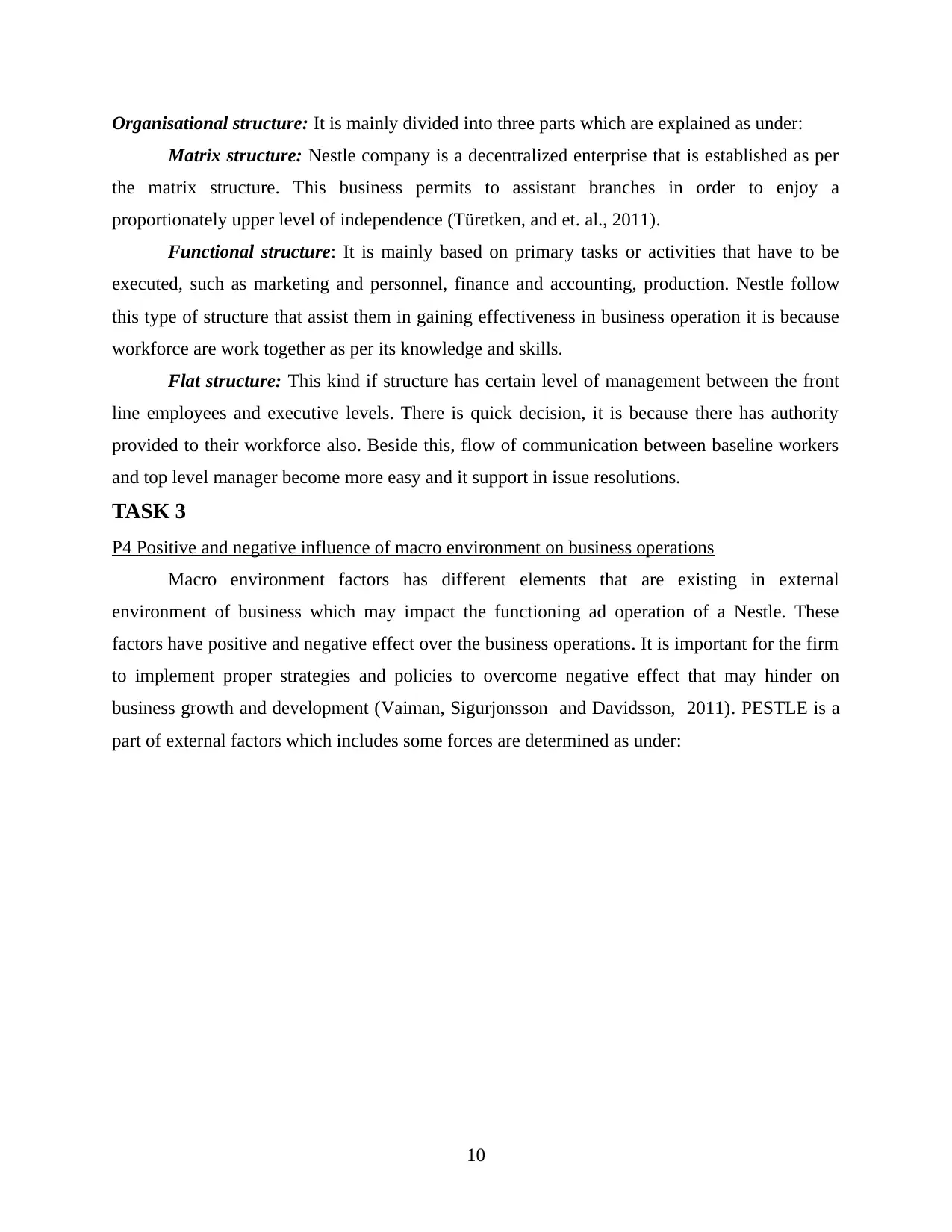
Organisational structure: It is mainly divided into three parts which are explained as under:
Matrix structure: Nestle company is a decentralized enterprise that is established as per
the matrix structure. This business permits to assistant branches in order to enjoy a
proportionately upper level of independence (Türetken, and et. al., 2011).
Functional structure: It is mainly based on primary tasks or activities that have to be
executed, such as marketing and personnel, finance and accounting, production. Nestle follow
this type of structure that assist them in gaining effectiveness in business operation it is because
workforce are work together as per its knowledge and skills.
Flat structure: This kind if structure has certain level of management between the front
line employees and executive levels. There is quick decision, it is because there has authority
provided to their workforce also. Beside this, flow of communication between baseline workers
and top level manager become more easy and it support in issue resolutions.
TASK 3
P4 Positive and negative influence of macro environment on business operations
Macro environment factors has different elements that are existing in external
environment of business which may impact the functioning ad operation of a Nestle. These
factors have positive and negative effect over the business operations. It is important for the firm
to implement proper strategies and policies to overcome negative effect that may hinder on
business growth and development (Vaiman, Sigurjonsson and Davidsson, 2011). PESTLE is a
part of external factors which includes some forces are determined as under:
10
Matrix structure: Nestle company is a decentralized enterprise that is established as per
the matrix structure. This business permits to assistant branches in order to enjoy a
proportionately upper level of independence (Türetken, and et. al., 2011).
Functional structure: It is mainly based on primary tasks or activities that have to be
executed, such as marketing and personnel, finance and accounting, production. Nestle follow
this type of structure that assist them in gaining effectiveness in business operation it is because
workforce are work together as per its knowledge and skills.
Flat structure: This kind if structure has certain level of management between the front
line employees and executive levels. There is quick decision, it is because there has authority
provided to their workforce also. Beside this, flow of communication between baseline workers
and top level manager become more easy and it support in issue resolutions.
TASK 3
P4 Positive and negative influence of macro environment on business operations
Macro environment factors has different elements that are existing in external
environment of business which may impact the functioning ad operation of a Nestle. These
factors have positive and negative effect over the business operations. It is important for the firm
to implement proper strategies and policies to overcome negative effect that may hinder on
business growth and development (Vaiman, Sigurjonsson and Davidsson, 2011). PESTLE is a
part of external factors which includes some forces are determined as under:
10
Paraphrase This Document
Need a fresh take? Get an instant paraphrase of this document with our AI Paraphraser
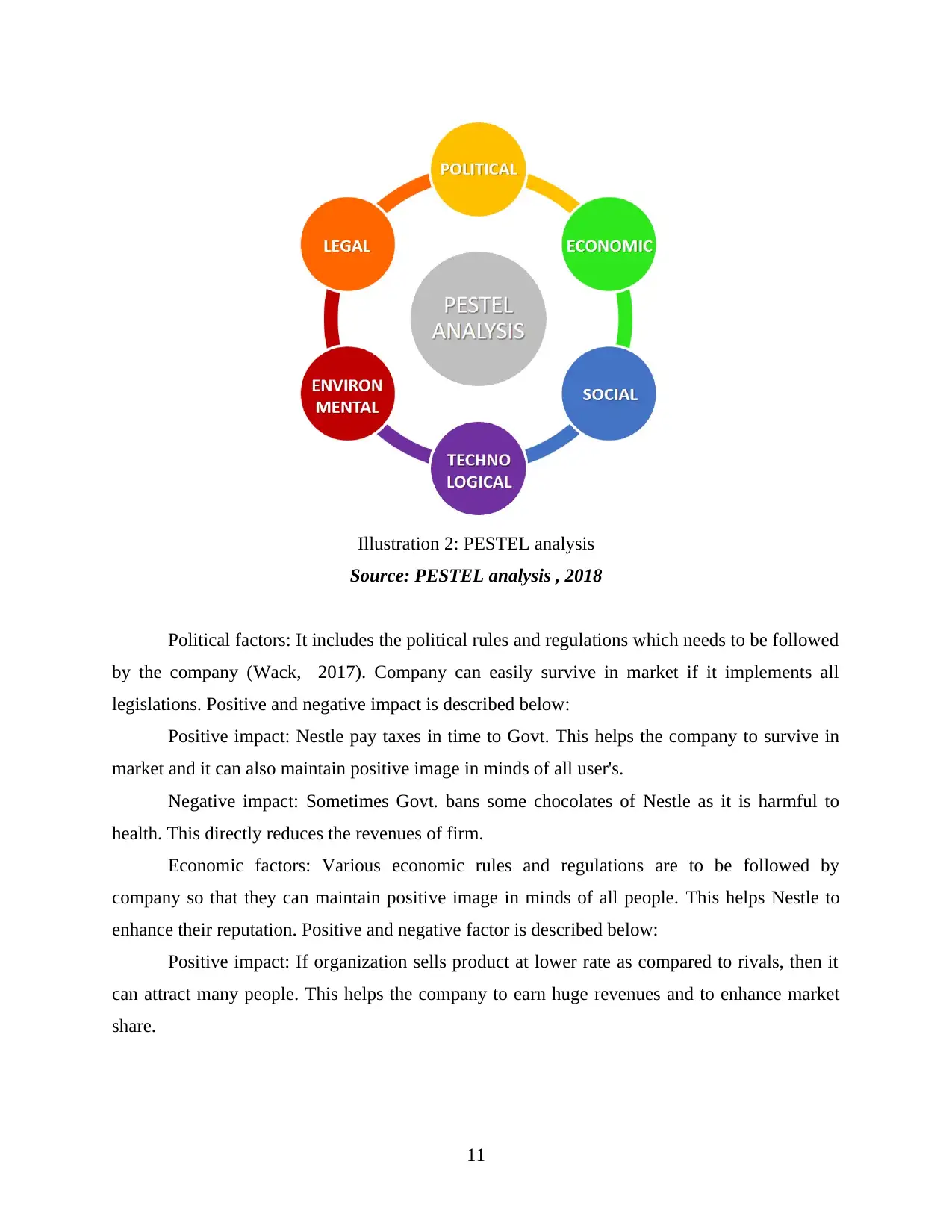
Source: PESTEL analysis , 2018
Political factors: It includes the political rules and regulations which needs to be followed
by the company (Wack, 2017). Company can easily survive in market if it implements all
legislations. Positive and negative impact is described below:
Positive impact: Nestle pay taxes in time to Govt. This helps the company to survive in
market and it can also maintain positive image in minds of all user's.
Negative impact: Sometimes Govt. bans some chocolates of Nestle as it is harmful to
health. This directly reduces the revenues of firm.
Economic factors: Various economic rules and regulations are to be followed by
company so that they can maintain positive image in minds of all people. This helps Nestle to
enhance their reputation. Positive and negative factor is described below:
Positive impact: If organization sells product at lower rate as compared to rivals, then it
can attract many people. This helps the company to earn huge revenues and to enhance market
share.
11
Illustration 2: PESTEL analysis
Political factors: It includes the political rules and regulations which needs to be followed
by the company (Wack, 2017). Company can easily survive in market if it implements all
legislations. Positive and negative impact is described below:
Positive impact: Nestle pay taxes in time to Govt. This helps the company to survive in
market and it can also maintain positive image in minds of all user's.
Negative impact: Sometimes Govt. bans some chocolates of Nestle as it is harmful to
health. This directly reduces the revenues of firm.
Economic factors: Various economic rules and regulations are to be followed by
company so that they can maintain positive image in minds of all people. This helps Nestle to
enhance their reputation. Positive and negative factor is described below:
Positive impact: If organization sells product at lower rate as compared to rivals, then it
can attract many people. This helps the company to earn huge revenues and to enhance market
share.
11
Illustration 2: PESTEL analysis

Negative factor: Sometimes all companies are selling product's at lower rate, then it is
difficult for company to attract people. Firm has to sell good quality of products to people to earn
revenues (Yu and Ramanathan, 2013).
Social: People demand and needs are changing day by day. Due to this change firm has to
create plans and policies to fulfil requirements of customer's. Positive and negative impact is
described below:
Positive factor: Nestle evaluates demand and requirement of all people. This help the
company to earn revenues and to maintain positive image in minds of all people.
Negative factors: Sometimes firm cannot fulfil all needs of people as wants ad
requirements are different. This helps in reducing the market share of company.
Technological factors: Company has to adopt latest techniques so that firm can create
distinct and unique products to all people. This helps the firm to capture many people in less
time. Positive and negative factor is described below:
Positive factor: Organization has adopted a recent technique and can create good quality
of products in minimum time. This helps the company to earn more revenues and to enhance
market share.
Negative factor: There are various competitors such as Cad bury which uses latest
technique in creating products. This reduces the revenues and firm has to create plans to beat
competitors.
Environmental: Company has to create plans and strategies to protect the environment.
This helps the company to maintain good image in society. Positive and negative impact is
described below:
Positive impact: Organization has created strategies to protect the environment. Firm has
to perform less wastage of resources and this helps company to earn huge revenues.
Negative impact: Firm creates smoke and pollution to environment as there are less
smokestacks . This helps in reducing revenues of organization.
Legal factors: It involves the legal environment of company and it has influence on the
activities and operation's of firm. Nestle has to follow the legal rules and regulations. Positive
and negative impact is described below:
12
difficult for company to attract people. Firm has to sell good quality of products to people to earn
revenues (Yu and Ramanathan, 2013).
Social: People demand and needs are changing day by day. Due to this change firm has to
create plans and policies to fulfil requirements of customer's. Positive and negative impact is
described below:
Positive factor: Nestle evaluates demand and requirement of all people. This help the
company to earn revenues and to maintain positive image in minds of all people.
Negative factors: Sometimes firm cannot fulfil all needs of people as wants ad
requirements are different. This helps in reducing the market share of company.
Technological factors: Company has to adopt latest techniques so that firm can create
distinct and unique products to all people. This helps the firm to capture many people in less
time. Positive and negative factor is described below:
Positive factor: Organization has adopted a recent technique and can create good quality
of products in minimum time. This helps the company to earn more revenues and to enhance
market share.
Negative factor: There are various competitors such as Cad bury which uses latest
technique in creating products. This reduces the revenues and firm has to create plans to beat
competitors.
Environmental: Company has to create plans and strategies to protect the environment.
This helps the company to maintain good image in society. Positive and negative impact is
described below:
Positive impact: Organization has created strategies to protect the environment. Firm has
to perform less wastage of resources and this helps company to earn huge revenues.
Negative impact: Firm creates smoke and pollution to environment as there are less
smokestacks . This helps in reducing revenues of organization.
Legal factors: It involves the legal environment of company and it has influence on the
activities and operation's of firm. Nestle has to follow the legal rules and regulations. Positive
and negative impact is described below:
12
⊘ This is a preview!⊘
Do you want full access?
Subscribe today to unlock all pages.

Trusted by 1+ million students worldwide
1 out of 18
Related Documents
Your All-in-One AI-Powered Toolkit for Academic Success.
+13062052269
info@desklib.com
Available 24*7 on WhatsApp / Email
![[object Object]](/_next/static/media/star-bottom.7253800d.svg)
Unlock your academic potential
Copyright © 2020–2025 A2Z Services. All Rights Reserved. Developed and managed by ZUCOL.




